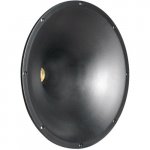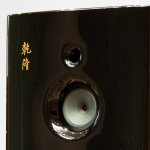Right, so a horn must have a rollover with a radius acoustically large enough to keep it from diffracting [note the large dark horn]: https://www.cessaro.de/fileadmin/site/html/images/products/alpha.jpg
GM
GM
Right, so a horn must have a rollover with a radius acoustically large enough to keep it from diffracting [note the large dark horn]: https://www.cessaro.de/fileadmin/site/html/images/products/alpha.jpg
GM
What audible effects does diffraction have on the sound? Just curious as currently I have a SEOS 15/DE250 sitting atop the woofer cabinet by itself. XO is around 1kHz.
Cheers,
Matt
Perceval - what's the dimensions of your rectangular horn? The horn in the link GM posted is huge, 100cm. In the Cessaro home page link, they show a "Qianlong" system that has a horn like coupler on both speakers, but the larger speaker's arrangement is closest to what I was imagining hacking the Dayton product.
So, what's going on when someone puts a circular waveguide over the top of a speaker, as they've clearly done in this Cessaro Qianlong system?
So, what's going on when someone puts a circular waveguide over the top of a speaker, as they've clearly done in this Cessaro Qianlong system?
Attachments
Last edited:
What audible effects does diffraction have on the sound?
Varies, kind of like a [added] sibilance that lots of folks like as it adds 'clarity'/'detail' and/or adds a layer of fine noise that lots of folks like for its 'richness' kind of like vinyl does [at least old vinyl, no experience with digital].
Experiment with some open cell foam wrapped around the mouth, extending a bit in front and wad up some cheap cotton towels to place around it to isolate it from the cab to get the worst of it.
Experiment with fish tank filters in the throat and adjust the HF if need be.
GM
So, what's going on when someone puts a circular waveguide over the top of a speaker
Load it with a point source driver like in your 1st post or a horn literally above a woofer box?
GM
GM, I was thinking of using a 4" point-source driver. Currently mounted on an 8" circular baffle, centered. I've read that this is worst case for diffraction and was wondering if this waveguide by Dayton could pull the sound away from interacting with the circular baffle board. Given the waveguide is circular also and of reasonable size. I'm also considering introducing a new baffle board shape, that I can just sandwich atop the existing circular one. I have no idea what shape I should make it - another + for Dayton's product. Given that its effect would be beneficial, which is my true question.
About 30 years ago, I was led to a church that was throwing out some speakers. All the drivers were long gone, but one thing I picked up was a multicell horn like on top of the speaker in your avatar picture. Whoever took the driver unbolted it at the horn throat, where each horn cell starts in a radial pattern. I vaguely recall building a plate to put a regular speaker at that point, slot loaded to match the throat geometry. It made sound, I used it for something like part of a PA system, then all memory of it is lost. Thanks,
About 30 years ago, I was led to a church that was throwing out some speakers. All the drivers were long gone, but one thing I picked up was a multicell horn like on top of the speaker in your avatar picture. Whoever took the driver unbolted it at the horn throat, where each horn cell starts in a radial pattern. I vaguely recall building a plate to put a regular speaker at that point, slot loaded to match the throat geometry. It made sound, I used it for something like part of a PA system, then all memory of it is lost. Thanks,
Last edited:
Indeed it is; it in theory has an infinite number of the same eigenmode, so sums as one 'massive' harmonic wave comb filtering with the driver's output. Offset the driver at an acoustic or golden ratio and you have the exact opposite, a very diffuse, low energy 'haze'.
Fine for a flat baffle, not so much with a horn/WG and why foam inserts and/or foam or other damping material around its perimeter is used to damp these, so placing an odd shaped baffle on top of it won't change it, just add some more random eigenmodes to the 'mix'.
GM
Fine for a flat baffle, not so much with a horn/WG and why foam inserts and/or foam or other damping material around its perimeter is used to damp these, so placing an odd shaped baffle on top of it won't change it, just add some more random eigenmodes to the 'mix'.
GM
Varies, kind of like a [added] sibilance that lots of folks like as it adds 'clarity'/'detail' and/or adds a layer of fine noise that lots of folks like for its 'richness' kind of like vinyl does [at least old vinyl, no experience with digital].
Experiment with some open cell foam wrapped around the mouth, extending a bit in front and wad up some cheap cotton towels to place around it to isolate it from the cab to get the worst of it.
Experiment with fish tank filters in the throat and adjust the HF if need be.
GM
Thank you.
Experiment with some open cell foam wrapped around the mouth, extending a bit in front and wad up some cheap cotton towels to place around it to isolate it from the cab to get the worst of it.
Forgot to include..........or better yet, just wrap the entire horn/driver with a thick down bed comforter or with one or more layers of a blanket to mimic it with it extended a bit forward of the mouth to ensure no reflections other than those generated inside the horn.
GM
- Status
- Not open for further replies.
- Home
- Loudspeakers
- Full Range
- Horn waveguide atop a 4" FR driver?

